Hoysaleshwara Temple, Halebidu
Keywords: Hoysala Temples, Hoysaleshwara Temple, Halebidu
Halebidu is about 30 min from Belur and about 210 kms from Bangalore.
Location: Hoysaleswara Temple, Halebidu
Hoysaleswara temple is a temple dedicated to the Hindu god Shiva. It was built in Halebidu during the rule of King Vishnuvardhana of the Hoysala Empire in the 12th century. The construction was started around 1120 CE and completed in 1150 CE.
(Source: https://en.wikipedia.org/wiki/Hoysaleswara_Temple).
Interesting Facts about Hoysaleshwara Temple
Temple Entrance
The temple is a simple dvikuta vimana (plan with two shrines and two superstructures), one for "Hoysaleswara" (the king) and the other for "Shantaleswara" (named after Shantala Devi, queen of King Vishnuvardhana) and is built with chloritic chist (more commonly known as Soapstone or potstone). The temple complex as a whole is elevated on a jagati (platform).
Sanctum
The two mantapas are connected giving a large and imposing view of the hall.
The two mantapas are connected giving a large and imposing view of the hall.
Deity
Individually, each shrine is smaller than the one at the Chennakesava Temple at Belur and contains a simple linga, the universal symbol of the god Shiva.
Individually, each shrine is smaller than the one at the Chennakesava Temple at Belur and contains a simple linga, the universal symbol of the god Shiva.
The architecture is simply amazing and the craftsmanship is just out of this world.
Shilabalikas and Dwarapalas
Some of the sculpted idols depict highly ornate dancing postures of the queen Shantaladevi - wife of Vishnuvardhana. The detailing is so intricate that you can actually pass light through the necklaces.
Open Pavillion
Some of the sculpted idols depict highly ornate dancing postures of the queen Shantaladevi - wife of Vishnuvardhana. The detailing is so intricate that you can actually pass light through the necklaces.
There are similar idols of doorkeepers at the temple entrances commonly referred as Dwarapalakas.
The temple has four porches for
entry and the one normally used by visitors as main entry is actually a lateral
entrance (north). There is one entry on the south side and two on the east
side, facing two large detached open pavilions whose ceiling is supported by
lathe turned pillars.
Nandi Idol
The pavilions enshrine large images of Nandi, the bull, an attendant of Shiva.
The pavilions enshrine large images of Nandi, the bull, an attendant of Shiva.
Temple Outer Walls
The temple outer walls display some of the finest and most detailed carvings observed anywhere else in India. It portrays theological, social and economic perspectives of the 11th century. One can locate gods and goddesses, musicians, dancers, war scenes, mysterious animals etc. on the walls.
King's Bodyguard
The Garuda pillar at the Hoysaleswara temple in Halebidu was erected in honor of Kuvara Lakshma, a minister and bodyguard of King Veera Ballala II. It is stated in the inscriptions that after the death of king Ballala, Kuvara beheaded other bodyguards, his wife and then himself. This episode is clearly depicted in the Garuda pillar.
Decline of Hoysalas
The Hoysala Empire and its capital Dvarasamudra was invaded, plundered and destroyed in early 14th century by the Delhi Sultanate armies of Alauddin Khilji, with Belur and Halebidu becoming the target of plunder and destruction in 1326 CE by another Delhi Sultanate army of Sultan Muhammad bin Tughlaq. The territory was taken over by the Vijayanagara Empire.


















Comments
Post a Comment